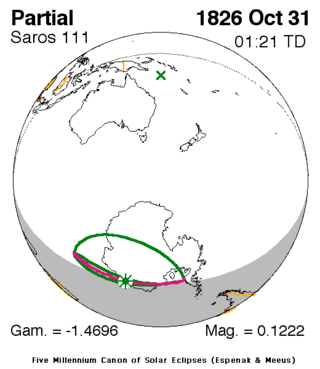Solar eclipse of October 31, 1826
A partial solar eclipse occurred on October 31, 1826 during spring, also known as the 1826 Halloween eclipse. A solar eclipse occurs when the Moon passes between Earth and the Sun, thereby totally or partly obscuring the image of the Sun for a viewer on Earth. A partial solar eclipse occurs in the polar regions of the Earth when the center of the Moon's shadow misses the Earth.
| Solar eclipse of October 31, 1826 | |
|---|---|
 Map | |
| Type of eclipse | |
| Nature | Partial |
| Gamma | -1.4696 |
| Magnitude | 0.1222 |
| Maximum eclipse | |
| Coordinates | 70.6°S 21.2°E |
| Times (UTC) | |
| Greatest eclipse | 1:20:39 |
| References | |
| Saros | 111 (73 of 79) |
| Catalog # (SE5000) | 9107 |
It was the second of three partial eclipses that took place that year, the first of two in two months, the next was on November 29 and covered a part of the Northern Hemisphere.[1] It was part of solar saros 111.[2]
Description
The eclipse was visible in Northern and Southern Antarctica including the South Pole, a tiny portion near the Antarctic Peninsula, a tiny part of the Atlantic and the Indian Ocean. It was during the decade that Antarctica was being explored by Europeans and added to the known atlas of the time.
The eclipse started at sunrise in the Indian Ocean at around the 50th meridian east, it finished at sunset not far from the Antarctic Peninsula.
It showed about up to 20-25% obscuration in Antarctica. The greatest eclipse was in Antarctica at 70.6 S, 21.2 E at 1:20 UTC (2:20 AM local time).[1]
The subsolar marking was in the Coral Sea.
See also
- List of solar eclipses in the 19th century
- List of solar eclipses visible from Antarctica
References
- "Solar eclipse of October 31, 1826". NASA. Retrieved March 14, 2017.
- "Solar Saros 111". NASA. Retrieved March 13, 2017.
.jpg)
